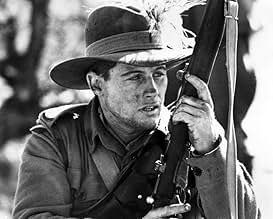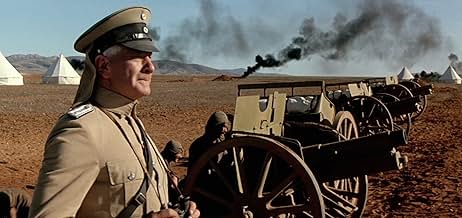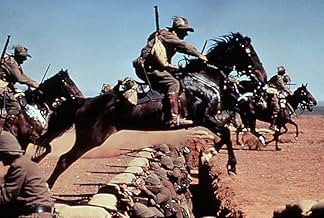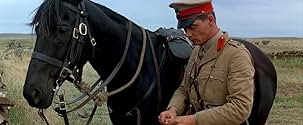VALUTAZIONE IMDb
6,8/10
2170
LA TUA VALUTAZIONE
Aggiungi una trama nella tua linguaIn 1917 when the British forces are bogged down in front of the Turkish and German lines in Palestine they rely on the Australian light horse regiment to break the deadlock.In 1917 when the British forces are bogged down in front of the Turkish and German lines in Palestine they rely on the Australian light horse regiment to break the deadlock.In 1917 when the British forces are bogged down in front of the Turkish and German lines in Palestine they rely on the Australian light horse regiment to break the deadlock.
- Regia
- Sceneggiatura
- Star
- Premi
- 2 vittorie e 1 candidatura in totale
Jack Heywood
- Dave's Dad
- (as John Heywood)
Recensioni in evidenza
This movie also has to go on my "desert island" list. What most people will say is that the first hour is about as exciting as watching paint dry, which is true to a point. But wars are often played like chess, and if you don't know the board you'll never understand the game. It's therefore necessary, though somewhat tedious, to show the situation, terrain, weather, and overall political climate to get to the historical charge. The Germans are played perhaps a little too stiffly, and the one Aussie who couldn't shoot a human and became a medic was perhaps given a little too much screen time. As for the charge itself, you can hear your heart beating faster as you literally smell the sweat from the horses. The two-mile charge against an entrenched enemy supported with machine gun, razor wire, and cannon is intense beyond words, and stands as some of the most awesome cinematography I've ever seen. Actual casualty stats are listed, which are surprisingly low. As for how the horses were handled, not one was injured-a feat you'll scarcely believe after having seen the charge. The Lighthorsemen, unlike Gallipoli, is well worth a look. -Chuck
This colossal 1987 production - believe it or not - from RKO PICTURES is an Australian film closely resembling LAWRENCE OF ARABIA in its intent and rightly compared to ZULU. With a huge cast of Oz actors and directed by PHAR LAP (look it up) warhorse Simon Wincer it is basically about the last massive charge in the Middle East desert during World War One....an event still on the yearly Australian military forces roster of "Anzac" celebrations. Many other comments on this site will give you details of the history of the event and rightly applaud this lavish spectacular film. RKO Pictures had reformed with some co financing in the 80s and this is one of their few productions. BEST LITTLE WHOREHOUSE and THE BORDER are two others that spring to mind produced with Universal Pictures. With a $7 million budget and all of it on screen THE LIGHTHORSE became the last of the truly international films from Australia in the 80s. Others of this time are GALLIPOLI and CAREFUL HE MIGHT HEAR YOU and THE MAN FROM SNOWY RIVER and WE OF THE NEVER NEVER...each are films made with a lavish widescreen cinema release in mind and each huge Oz successes. THE LIGHTHORSEMEN is well worth the 140 minutes or so of carefully paced storytelling, all laced with Aussie humor and superb design and photography. The charge in the last two reels is truly breathtaking and on a cinema screen was particularly overwhelming, rivaling the battle charge in LAWRENCE OF ARABIA for sheer thrilling visuals. No CGI in this film... it is all real and scary and played and filmed for keeps. One thrill for cinema owners of the day was to have the film commence with the original cinema scope RKO logo...beeping away from the tower on top of the world. Wonderful!
This is a story about some episode British-Turk campaign in Palestine in 1917. Very important role in this campaign was played by Australian forces. The key to conquer the Holy Land is city of Gaza. British general wants however to throw his forces to bypass the city and capture another one - Beersheba. To take them both it is necessary to keep his plan secret.
As a person who is interested in all WWI history I was waiting for this movie. I find it very good. All equipment seems to be very accurate, however, I've never heard about use of tanks in this front. There is a nice scene of air attack by German biplane, cars from that times, uniforms, and so on -- it all seems to be historical correct. The final charge is worth waiting for. I think that anyone who is interested in this campaign would be satisfied.
Because of Australian point of view the role of British army seems to be a little underrated. I especially mean British commander -- general Allenby. I think it would be good to say at the very end that after capturing Beersheba, Gaza fell as well a week later, and the road to Jerusalem was opened. This was what was lacking for me.
As a person who is interested in all WWI history I was waiting for this movie. I find it very good. All equipment seems to be very accurate, however, I've never heard about use of tanks in this front. There is a nice scene of air attack by German biplane, cars from that times, uniforms, and so on -- it all seems to be historical correct. The final charge is worth waiting for. I think that anyone who is interested in this campaign would be satisfied.
Because of Australian point of view the role of British army seems to be a little underrated. I especially mean British commander -- general Allenby. I think it would be good to say at the very end that after capturing Beersheba, Gaza fell as well a week later, and the road to Jerusalem was opened. This was what was lacking for me.
This impressive flick is based on a true story and most of the characters in the film were based on real people and dealing with the continued coming of age of the Australian nation and its soldiers . The film follows Four Australians, Frank (Gary Sweet), Scotty (Jon Blake who was injured in a car accident and he suffered permanent paralysis and brain damage until his recent death) an Irish-Australian, Chiller (Tim McKenzie) and Tas (John Walton) in Palestine in 1917, part of the 4th Light Horse Brigade of the British and Commonwealth Dominion forces. When Frank is wounded and dies of his wounds, he is replaced by Dave (Peter Phelps). Dave finds himself unable to fire his weapon in combat and is transferred to the Medical Corps, where he will not need to carry a weapon, but where he will still be exposed to the fighting . After the Second Battle of Gaza ended in complete failure, General Archibald Murray (Tony Bonner) , the commander in chief of the British forces in Egypt and Palestine, was replaced by the distinguished cavalry commander, General Edmund Allenby (Anthony Hawkins) , formerly the commander of the British Third Army on the Western Front to carry out the British plan the capture of Beersheba. During an attack by Turkish cavalry, Major Richard Meinertzhagen (Anthony Andrews) deliberately leaves behind documents indicating that the attack on Beersheba will only be a diversion. At the ending there takes place the Battle of Beersheba (Turkish: Birüssebi Savaşı) that was one critical element of a wider British offensive, known as the Third Battle of Gaza, aimed at breaking the Ottoman defensive line that stretched from Gaza on the Mediterranean shore to Beersheba ; it took place on 31 October 1917, as part of the Sinai and Palestine campaign during World War I . Notable was the charge of the Australian 4th Light Horse Brigade, which covered some 6 kilometres (3.7 mi) to overrun and capture the last remaining Ottoman trenches, and secure the surviving wells at Birüssebi . The total losses incurred by the Desert Mounted Corps was 53 men killed and 144 wounded. The heaviest Allied losses were suffered by the British infantry of XX Corps, which lost 116 killed in action, although the total number of men killed during the battle from the British force was far greater, totalling 171 men.
It follows in the wake of other Australian New Wave war movies such as Breaker Morant (1980), Gallipoli (1981), and the 5-part TV series Anzacs (1985). Recurring issues of these films include the Australian identity , such as mateship and friendship , ANZAC spirit , the loss of innocence in war, and breathtaking battles spectacularly filmed . Acceptable acting from main and support cast including prestigious Aussie/English actors such as Anthony Andrews , Shane Bryant , Sigrid Thornton , Tony Bonner , Gary Tweed , Bill Kerr , though none of the performances are really bad, but none are very good . Gorgeous outdoors are well photographed by cameraman Dan Cundey . Despite being set in Palestine and Egypt, the film was shot entirely on location in Victoria and Hawker, South Australia . Rousing and emotive musical score was composed by Mario Millo. It was nominated for Best Achievement in Cinematography and won an Australian Film Institute award in 1988 for Best Original Music Score and another for Best Achievement in Sound. It grossed a lot of money at the box office in Australia . Sensational directorial by the notorious filmmaker Simon Wincer, a Western expert, as he emigrated Hollywood and subsequently directed to Tom Selleck in ¨Monte Walsh¨ , ¨Crossfire trail¨ and ¨Quigley Down Under¨ to Paul Hogan in ¨Relampago Jack¨ and ¨Cocodrile Dundee in L.A.¨ and usually directs episodes for TV mini-series, such as ¨Into the West¨, ¨The Ponderosa¨ , ¨Lonesome Dove¨ and ¨The adventures of young Indiana Jones¨ , among others . Rating: good for the sensitive direction and proficient film-making ; the result is a sort of pacifist-aggressive war adventure . Worthwhile watching .
It follows in the wake of other Australian New Wave war movies such as Breaker Morant (1980), Gallipoli (1981), and the 5-part TV series Anzacs (1985). Recurring issues of these films include the Australian identity , such as mateship and friendship , ANZAC spirit , the loss of innocence in war, and breathtaking battles spectacularly filmed . Acceptable acting from main and support cast including prestigious Aussie/English actors such as Anthony Andrews , Shane Bryant , Sigrid Thornton , Tony Bonner , Gary Tweed , Bill Kerr , though none of the performances are really bad, but none are very good . Gorgeous outdoors are well photographed by cameraman Dan Cundey . Despite being set in Palestine and Egypt, the film was shot entirely on location in Victoria and Hawker, South Australia . Rousing and emotive musical score was composed by Mario Millo. It was nominated for Best Achievement in Cinematography and won an Australian Film Institute award in 1988 for Best Original Music Score and another for Best Achievement in Sound. It grossed a lot of money at the box office in Australia . Sensational directorial by the notorious filmmaker Simon Wincer, a Western expert, as he emigrated Hollywood and subsequently directed to Tom Selleck in ¨Monte Walsh¨ , ¨Crossfire trail¨ and ¨Quigley Down Under¨ to Paul Hogan in ¨Relampago Jack¨ and ¨Cocodrile Dundee in L.A.¨ and usually directs episodes for TV mini-series, such as ¨Into the West¨, ¨The Ponderosa¨ , ¨Lonesome Dove¨ and ¨The adventures of young Indiana Jones¨ , among others . Rating: good for the sensitive direction and proficient film-making ; the result is a sort of pacifist-aggressive war adventure . Worthwhile watching .
A First World War Australian cavalry -- sorry, mounted infantry -- film set in the Holy Land, that's not something one tends to see every day. So, for me, the fact that, yes, the characters and situations can be a little clichéd at times is far outweighed by the novelty of the whole scenario. Quibbles are easy to put to one side.
The cavalry distinction is important. Cavalry would be armed with carbines and sabres. Mounted infantry have rifles and dismount in order to fight. This subtlety plays a part in the outcome.
A series of small skirmishes heightens tension within the film until the exciting finale, when there is a fantastic, large scale, cav ... mounted infantry charge which got my pulse racing. You'll recall something similar in David Lean's "Lawrence of Arabia". This set piece is bigger. Johnny Turk was the villain that time too.
This being an Australian Imperial Force meets the British Army sort of film, there is bound to be a little Pommy-bashing going 'round. When I lived briefly in Australia a decade ago, I found Pommy-bashing to be the single unattractive facet to the Australian national character. (The Kiwis don't do it. We like Poms here too. Pity the Dominions can't agree on that one.) So while some of the Poms in this film might be a few sheep short of a paddock, still there *is* balance, with one Pom who is much cleverer than the average. Bashing even works its way into the plot, a nice touch that.
The film does not use an excessive amount of Strine lingo -- billy, tucker -- so very little acclimatization is necessary for the uninitiated.
I can't vouch for the overall authenticity of this film. But I did notice that campaign map in the Turkish commander's office. It's labelled in Arabic only. Egypt is identified as "Misr". Geez, that is the correct Arabic name. And the Ottomans were still using the Arabic alphabet at the time. (It's Atatürk after the war who switched Turkish over to the Roman alphabet.) The thing's fair dinkum, mate. If they cared enough to get details like that right, then I'm sure that says a lot about the effort put into the film as a whole.
There is an earlier Australian film about the Light Horse I'd like to see, "Forty Thousand Horsemen" from 1940 or '41 (sources differ). Finding a copy of that film in this hemisphere though would be extraordinary, a bit like finding a North American who likes Vegemite.
The cavalry distinction is important. Cavalry would be armed with carbines and sabres. Mounted infantry have rifles and dismount in order to fight. This subtlety plays a part in the outcome.
A series of small skirmishes heightens tension within the film until the exciting finale, when there is a fantastic, large scale, cav ... mounted infantry charge which got my pulse racing. You'll recall something similar in David Lean's "Lawrence of Arabia". This set piece is bigger. Johnny Turk was the villain that time too.
This being an Australian Imperial Force meets the British Army sort of film, there is bound to be a little Pommy-bashing going 'round. When I lived briefly in Australia a decade ago, I found Pommy-bashing to be the single unattractive facet to the Australian national character. (The Kiwis don't do it. We like Poms here too. Pity the Dominions can't agree on that one.) So while some of the Poms in this film might be a few sheep short of a paddock, still there *is* balance, with one Pom who is much cleverer than the average. Bashing even works its way into the plot, a nice touch that.
The film does not use an excessive amount of Strine lingo -- billy, tucker -- so very little acclimatization is necessary for the uninitiated.
I can't vouch for the overall authenticity of this film. But I did notice that campaign map in the Turkish commander's office. It's labelled in Arabic only. Egypt is identified as "Misr". Geez, that is the correct Arabic name. And the Ottomans were still using the Arabic alphabet at the time. (It's Atatürk after the war who switched Turkish over to the Roman alphabet.) The thing's fair dinkum, mate. If they cared enough to get details like that right, then I'm sure that says a lot about the effort put into the film as a whole.
There is an earlier Australian film about the Light Horse I'd like to see, "Forty Thousand Horsemen" from 1940 or '41 (sources differ). Finding a copy of that film in this hemisphere though would be extraordinary, a bit like finding a North American who likes Vegemite.
Lo sapevi?
- QuizWebsite Cinephilia reports of the Jon Blake accident and legal case: "Jon Blake was critically injured whilst driving home on December 1, 1986, after the final day's filming of The Lighthorsemen - Attacco nel deserto (1987). He sustained severe brain injuries and in December, 1995, the New South Wales Supreme Court ruled that Blake should be compensated for the loss of potential earnings as a star in the United States. After taking evidence from actors, directors, and film critics who indicated his career could have been as big as Mel Gibson's, the court awarded him $32 million in damages. This was later reduced to $7 million after the defence appealed."
- BlooperAt the rest camp just after the 2 soldiers pass the British Major and addresses the Colonel about the men wearing shorts at the end the Colonel calls the Major 'Sir', this wouldn't happen as a Colonel is a higher rank to Major.
- Versioni alternativeUK versions are cut by 6 secs to remove cruel horsefalls.
- ConnessioniEdited into Le avventure del giovane Indiana Jones: Palestine, October 1917 (1993)
- Colonne sonoreAUSTRALIA WILL BE THERE
Music and lyrics by W.W. 'Skipper' Francis
By Arrangement with Allans Music (Australia) Pty. Limited
I più visti
Accedi per valutare e creare un elenco di titoli salvati per ottenere consigli personalizzati
- How long is The Lighthorsemen?Powered by Alexa
Dettagli
- Data di uscita
- Paese di origine
- Siti ufficiali
- Lingua
- Celebre anche come
- The Lighthorsemen
- Luoghi delle riprese
- St. Kilda, Melbourne, Victoria, Australia(beach, Mediterranean Sea)
- Aziende produttrici
- Vedi altri crediti dell’azienda su IMDbPro
Botteghino
- Budget
- 10.500.000 A$ (previsto)
- Lordo Stati Uniti e Canada
- 33.779 USD
- Fine settimana di apertura Stati Uniti e Canada
- 23.645 USD
- 10 apr 1988
- Lordo in tutto il mondo
- 34.514 USD
- Tempo di esecuzione
- 2h 11min(131 min)
- Mix di suoni
- Proporzioni
- 2.35 : 1
Contribuisci a questa pagina
Suggerisci una modifica o aggiungi i contenuti mancanti




























